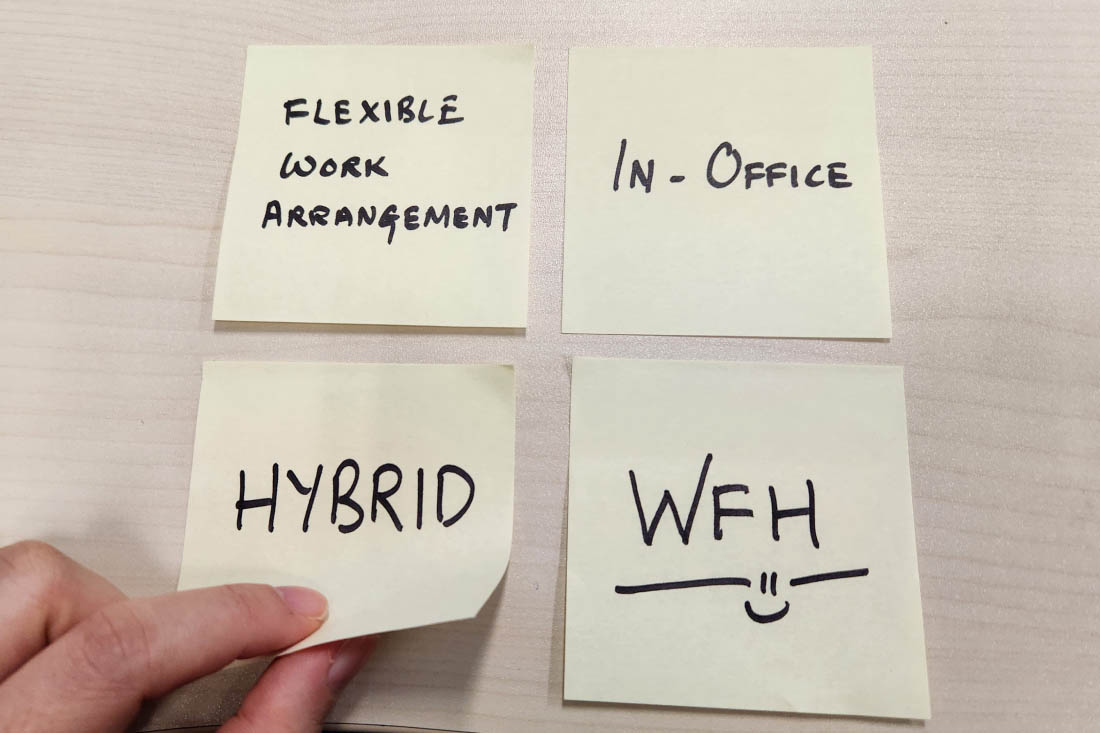Are you eager to build a hybrid work culture that’ll put you ahead of your competitors? You’ve come to the right place. In this guide, we walk you through six essential steps for creating a successful hybrid workforce strategy. We’ll show you:
- Why it's so important to assess your business needs first, before putting policies in place
- How to determine which hybrid work model makes the most sense for your unique workforce
- Which steps to rinse and repeat to ensure your hybrid work policies stay relevant as the landscape changes
Whether you’re new to hybrid work or want to improve your existing policies, this guide provides a practical approach for any business leader.
What is a hybrid workforce strategy?
A hybrid workforce strategy defines your organization's approach to hybrid work. It includes guidelines on who works from where and when, along with the policies you’ll enforce. More importantly, it outlines the steps you’ll take to help employees stay as productive as possible in any environment. A strong hybrid workforce strategy is designed to meet company needs while improving the employee experience and prioritizing well-being.
Why is it important to have a hybrid workforce strategy?
Establishing a clear hybrid workforce strategy sets you up for long-term success, ensuring the policies you set today will lead to all kinds of benefits tomorrow. Over time, your strategy empowers you to increase:
- Employee engagement and retention: Numerous surveys, such as one conducted by Slack, show most employees prefer hybrid work over exclusively in-office or remote policies. They appreciate the flexibility it provides and are less likely to look for another job.
- Employee productivity: If your hybrid workforce strategy frees employees to work where and when they perform best, more productivity is bound to ensue. For example, consider what happened at HubSpot: After three years of experimenting with different strategies, the company discovered its hybrid sales teams are 28% more likely to outperform fully in-person or fully remote employees.
- Work-life balance: For people to give their best at work, they must also meet their personal needs. The right hybrid work strategy empowers your employees to do just that. When Gallup asked employees what they like about hybrid work, 76% said it improves work-life balance.
- Office space utilization: Once you understand how often people actually need to meet in person, you can use this information to your advantage. Many companies save money on rent and utilities by calculating office space needs as part of their hybrid workforce strategy.
When you’re intentional about getting hybrid work right, you do more than just boost employee satisfaction. You also cover your most important business needs, from using the right amount of physical office space to improving talent acquisition.
6 steps to develop a hybrid workforce strategy
A successful hybrid workplace strategy meets your organization’s needs while prioritizing employee well-being. While every blueprint will be slightly different, following these steps helps set you up for success.
1. Assess your business needs
Before you implement or update your hybrid work policies, it’s crucial to first assess the specific needs of your business. Identify which roles make sense for remote work and which ones require a physical presence, and analyze your teams’ current workflows to determine who needs to be in the office — and how often.
However, don’t assume you know what people need to be productive. It’s equally important to solicit employee feedback for insights on how often employees want — or need — to come into the office, as well as any limitations they might currently face when working from home. Understanding these preferences will influence how much office space you need and what technology you should invest in.
Better yet, use hybrid workforce management software like ActivTrak to see where your employees are most productive. This tool collects and analyzes real-time employee activities to identify what each team needs to thrive — whether that means more dedicated focus time at home or opportunities for in-person collaboration in the office. The key is to find out what works best for your unique workforce.
2. Determine your ideal hybrid work model
Once you’ve thoroughly analyzed your business needs, the next step is to identify the best hybrid work model for your teams based on those findings. The goal is to find your ideal mix of in-person and remote work — the one that helps you create a more productive, engaged workforce.
Take your time on this step. Rather than rushing into a new setup, explore various hybrid work models to see how they’ve worked for other businesses in your industry. Some companies require employees to report to the office two or three days a week, while others let people work primarily from home and keep office space available for times teams need to meet in person. And many skip the company-wide mandates altogether, leaving it up to employees and managers to decide their own best schedules.
Any of these models may work well depending on what you discovered in step one above. Just be sure to factor in what your employees have to say about the matter. This is especially true for your high performers — ask what they need to remain as productive as possible. The answers might surprise you!
3. Create or update your hybrid work policy
Once you’ve established your business needs and identified the right model, the next step is to implement a hybrid work policy. Create clear expectations around which teams work remotely, and how often, along with security policies and any other guidelines you want them to follow. This ensures everyone’s on the same page and reduces the risk of misunderstandings.
Not sure where to start? Download ActivTrak’s hybrid work policy template for an easy-to-customize framework. This template is based on the experiences of thousands of hybrid teams across various industries and business sizes.
And don’t stress about getting every aspect of your policy right on the first try. Just be prepared to monitor productivity and performance so you can adjust specifics as needed. The most successful hybrid workforce strategies are the ones that evolve over time as needs change.
4. Optimize your tech stack
Creating a positive hybrid work environment hinges on the right technology. Which is why the next critical step is to evaluate your tech stack. Take time to identify the right tools to promote hybrid team collaboration — tools that help hybrid teams work together across different locations and time zones.
Start by looking at your current software to identify any apps you should scrap or replace. Include employees in your audit by asking them to answer questions such as:
- Do you like our current video conferencing software or would you recommend a different one?
- Do you feel you have everything you need to effectively manage tasks, assignments and projects when working from home?
- Are any tools too time-consuming or confusing?
To remove the guesswork from this step, use ActivTrak’s SaaS management software to see which tools people use daily — and which ones they rarely touch. This SaaS app visibility makes it easy to reduce wasted spend and invest in more of the tools hybrid employees need to be successful.
5. Encourage employee feedback
If there’s one step you don’t want to take, it’s building a strategy that’s set in stone. To build a hybrid environment where employees consistently go the extra mile, you need to constantly evaluate and test new ideas. And for that, employee feedback is key.
When employees and managers work together to determine what works best for each team, you can optimize your hybrid work strategy for even more success. Rather than forcing people to design their workweeks around strict schedules, ask people what works for them. While you don't have to accommodate every request, acknowledging and acting on feedback helps ensure your strategy factors in any important overlooked details.
6. Watch for signs of burnout
Once your strategy is in place and everyone’s following the same guidelines, monitor daily activities to ensure employee well-being. It’s often hard to see when hybrid workers are overworked or stressed out, especially if they spend a lot of time working remotely.
This is especially important for your top-performing team members. The lack of defined start and end times — not to mention 10-second commutes to the home office — make it easy to work…and work…and work some more. This quickly leads to burnout and disengagement, so it’s important to stay vigilant and watch for signs like unusually long work hours, decreased productivity and lower-quality performance.
Create and implement a hybrid workforce strategy with ActivTrak
Ready to harness the full potential of your hybrid workforce? ActivTrak offers the insights and analytics you need to create a strategy for the new era of work.
More than 9,500 customers use our award-winning hybrid workforce management software to gain visibility into team performance and make informed decisions that drive success.
Get started with a free account today! And if you’d like a behind-the-scenes look at the features other hybrid companies use, be sure to schedule a personalized demo.


